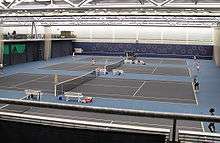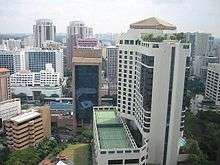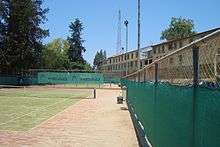Tennis court

A tennis court is the venue where the sport of tennis is played. It is a firm rectangular surface with a low net stretched across the center. The same surface can be used to play both doubles and singles matches. A variety of surfaces can be used to create a tennis court, each with its own characteristics which affect the playing style of the game.
Dimensions

Tennis is played on a rectangular flat surface, usually of grass, clay or hard material. The dimensions of a tennis court are defined and regulated by the International Tennis Federation (ITF) governing body and are written down in the annual 'Rules of Tennis' document.[1] The court is 78 feet (23.77 metres) long. Its width is 27 feet (8.23 metres) for singles matches and 36 feet (10.97 metres) for doubles matches.[2] The service line is 21 feet (6.40 metres) from the net.[2] Additional clear space around the court is needed in order for players to reach overrun balls for a total of 60 feet (18 metres) wide and 120 feet (37 metres) long. A net is stretched across the full width of the court, parallel with the baselines, dividing it into two equal ends. The net is 3 feet 6 inches (1.07 metres) high at the posts, and 3 feet (0.91 metres) high in the center.[3] The net posts are 3 feet (0.91 metres) outside the doubles court on each side or, for a singles net, 3 feet (0.91 metres) outside the singles court on each side.
Surfaces
Tennis is played on a variety of surfaces and each surface has its own characteristics which affect the playing style of the game. There are four main types of courts depending on the materials used for the court surface: clay courts, hard courts, grass courts and carpet courts. The International Tennis Federation (ITF) lists different surfaces and properties and classifies surfaces into one of five pace settings:[4]
- Category 1 (slow)
- Category 2 (medium-slow)
- Category 3 (medium)
- Category 4 (medium-fast)
- Category 5 (fast)
Of the current Grand Slam tournaments, the US Open and Australian Open use hard courts, the French Open is played on clay, and Wimbledon is played on grass and is the only Grand Slam tournament to have always been played on one surface. The Australian Open switched to hard courts in 1988 and in its early years the French championship alternated between clay and sand/rubble courts. The US Open is the only one of the four majors to have been played on three surfaces; the tournament was played on grass from its inception until 1974, on green clay until 1977, and on hard courts since the tournament moved from the West Side Tennis Club to the National Tennis Center in 1978.
ITF uses the following classification for tennis court surface types:[5]
| Surface code | Type | Description |
| A | Acrylic | Textured, pigmented, resin-bound coating |
| B | Artificial clay | Synthetic surface with the appearance of clay |
| C | Artificial grass | Synthetic surface with the appearance of natural grass |
| D | Asphalt | Bitumen-bound aggregate |
| E | Carpet | Textile or polymeric material supplied in rolls or sheets of finished product |
| F | Clay | Unbound mineral aggregate |
| G | Concrete | Cement-bound aggregate |
| H | Grass | Natural grass grown from seed |
| J | Other | E.g. modular systems (tiles), wood, canvas |
Clay courts

Clay courts are made of crushed shale, stone, or brick.[6] The French Open is the only Grand Slam tournament to use clay courts.
Clay courts slow down the ball and produce a high bounce in comparison to grass courts or hard courts.[6] For this reason, the clay court takes away many of the advantages of big serves, which makes it hard for serve-based players to dominate on the surface. Clay courts are cheaper to construct than other types of tennis courts, but a clay surface costs more to maintain. Clay courts need to be rolled to preserve flatness. The clay's water content must be balanced; green courts generally require the courts to be sloped to allow water run-off.
Clay courts are more common in Europe and Latin America than in North America and tend to heavily favour baseline players.
Grass courts

Grass courts are the fastest type of courts in common use.[6] They consist of grass grown on very hard-packed soil, which adds additional variables: bounces depend on how healthy the grass is, how recently it has been mown, and the wear and tear of recent play. Points are usually very quick where fast, low bounces keep rallies short, and the serve plays a more important role than on other surfaces. Grass courts tend to favour serve-and-volley tennis players.
Grass courts were once among the most common tennis surfaces, but are now rare due to high maintenance costs, as they must be watered and mown often, and take a longer time to dry after rain than hard courts. The grass surface, however, is the most compatible with the human body because of its softness.
Hard courts

Hard courts are made of uniform rigid material, often covered with an acrylic surface layer,[6] offering greater consistency of bounce than other outdoor surfaces.[7] Hard courts can vary in speed, although they are faster than clay but not as fast as grass courts. The quantity of sand added to the paint can greatly affect the rate at which the ball slows down.[8] The US Open is played on DecoTurf, while the Australian Open is played on Plexicushion, both acrylic topped hard court surfaces.
Carpet courts
"Carpet" in tennis means any removable court covering.[6] Indoor arenas store rolls of rubber-backed court surfacing and install it temporarily for tennis events, however they are not in use any more for professional events. A short piled form of artificial turf infilled with sand is used for some outdoor courts, particularly in Asia. Carpet is generally a fast surface, faster than hardcourt, with low bounce.[6]
Notable tennis tournaments previously held on carpet courts were the WCT Finals, Paris Masters, U.S. Pro Indoor and Kremlin Cup. Since 2009 their use has been discontinued on the ATP and WTA tours.
Indoor courts
Any court surface may be used indoors. Hard courts[7] are most common indoors, as they are made with the most versatile materials and surface finishes. Clay courts are installed indoors with underground watering systems, and used mostly for Davis Cup matches. The conclusion of the Wimbledon Championships, in 2012, was played on the lawn of the Centre Court under the roof and artificial lights. Carpet surfaces have been used both on the ATP World Tour and the World Championship Tennis circuit, though no events currently use them. Historically, other surfaces have been used indoors, such as hardwood at the defunct World Covered Court Championships and the London Indoor Professional Championships. Currently, the ATP World Tour Finals event is the most important indoor tennis tournament.
Smaller courts
The ITF campaign Play and Stay aims to increase tennis participation worldwide, by improving the way children are introduced to the game. The campaign promotes playing on smaller courts with slower red, orange and green balls. This gives children more time and control so that they can serve, rally, and score from the first lesson on courts that are sized to fit their bodies. The ITF has mandated that official competition for children under 10 years of age should be played on so-called Orange courts 18 m (59 ft) long by 6.4 m (21 ft) wide. Competition for children under 8 years is played on Red courts that are 11 m (36 ft) long and 5.5 m (18 ft) wide. The net is 0.8m high in the center.[9]
Terminology
Common tennis court terms:
- Advantage service box or ad court: The receiver's left side service box, or the opponent's right for the server; significant as the receiving side for an advantage point.
- Alley or Tramlines:[10] The lanes on each side of the singles court. These are only used when playing doubles.
- Back court: The area between the baseline and the service line.
- Baseline: The rearmost line of the court, furthest from and parallel to the net.
- Center service line: The line dividing the two service boxes on each side.
- Center mark: The 12-inch mark at the halfway point of the baseline used to distinguish the two halves (and service boxes) of a tennis court.
- Deuce service box or deuce court: The receiver's right side service box, or the opponent's left for the server, significant as the receiving side for a deuce point.
- Service box: The area on each side bounded by the singles sideline, the service line, and the net. There are left and right service boxes, separated by the center service line.
- Service line: The line that is parallel to the net and is located between the baseline and the net. It marks the end of the service boxes.
- Side T: The T shape formed by the service line and the singles sideline. There are four such side Ts, two on each side of the net.
- T or Middle T: The T shape formed by the service line and the center service line.
See also
References
- ↑ "ITF Rules of Tennis". ITF.
- 1 2 "Rule 1 – The Court". International Tennis Federation. Retrieved 29 May 2015.
- ↑ Rules of tennis
- ↑ "Court Pace Classification Programme". ITF. Retrieved 1 October 2012.
- ↑ "ITF Approved Tennis Balls, Classified Surfaces & Recognised Courts 2015" (PDF). ITF. p. 62.
- 1 2 3 4 5 6 "Surface Descriptions". itftennis.com. International Tennis Federation. Retrieved June 24, 2015.
- 1 2 "Hard Courts Make Tennis Champions". The New York Times. 3 November 1912.
- ↑ Tennis Universal
- ↑ ITF Play and Stay
- ↑ "BBC Sports: Basic rules of tennis". Retrieved 24 June 2015.

